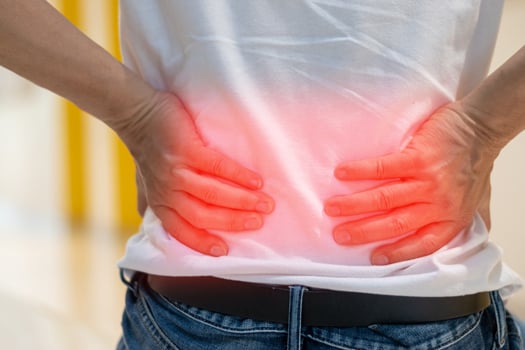
If you have a bulging spinal disc, you may be wondering if you can physically feel it. You are not likely to be able to feel the disc itself, since it is located between the bones of your spine. However, you may be able to determine the affected area by touching various points along your back that you can reach. This article explains more about bulging or protruding spinal discs.
Finding Sore Spots
The one thing you can feel with a bulging disc is whether it is sore when you touch the affected area. If you gently touch the area, you should be able to clearly tell when you have discovered the affected spinal disc. Depending on how the nerve is affected, the reaction to your touch may include:
• Immediate and sharp lower back pain
• Pain felt in nearby areas—a sign of nerve-related damage
• General muscle weakness
• Numbness and tingling sensations
What to Do when You Discover a Sore Spot
Once you find the affected area, the next step is to talk to your doctor or a spine specialist. This step is important, since there are many possible sources of spine-related pain. At the very least, you will have a good idea of the precise location of the affected area, which improves the accuracy of your diagnosis.
Danger of Ignoring a Bulging Disc
By the time you start to notice a protruding spinal disc, the disc is usually very close to becoming herniated. Herniation is when the inner material within the spinal disc gets outside through a crack or fracture in the outer shell. The potential risk with herniation is the nerve irritation is often more severe. By acting early and talking to your doctor, a bulging disc can be treated in a way that reduces the risk of having a full herniation.
Paying Attention to Early Signs
If you notice early signs and symptoms, it is a good idea to start gently touching various areas where you may have a bulging disc. The list of symptoms includes:
• Leg pain
• Lower back discomfort that keeps returning
• Pain that comes and goes based on your movements and activities
• Nerve-based discomfort that makes it difficult to walk
Acting early when you first notice spinal disc pain also boosts your odds of benefiting from nonsurgical treatments. The good news is surgery is rarely required for a bulging or herniated disc. However, if you postpone herniated disc treatment, the damage may become more severe, which can increase your risk of needing surgery at some point. If surgery becomes a possibility for you, there are minimally invasive options that are reliable and effective for many patients.
If you have a herniated disc that is not responding to conservative treatment, a discectomy may be discussed and potentially recommended. Although this is generally a very successful procedure, having a large hole in the outer ring of the disc more than doubles the risk of needing another operation. A new treatment, Barricaid, is a bone-anchored device that closes this hole, and 95 percent of Barricaid patients did not undergo a reoperation due to reherniation in a 2-year study timeframe. This treatment is done immediately following the discectomy—during the same operation—and does not require any additional incisions or time in the hospital.
If you have any questions about the Barricaid treatment, ask your doctor or contact us at 844-288-7474.
For full benefit/risk information, please visit: https://www.barricaid.com/instructions.


Comments